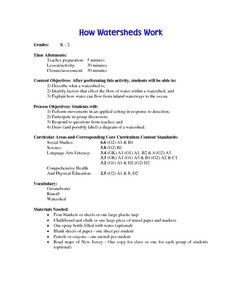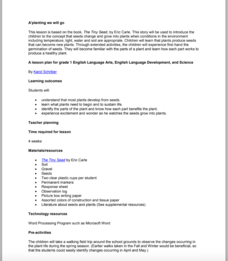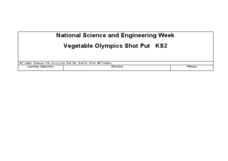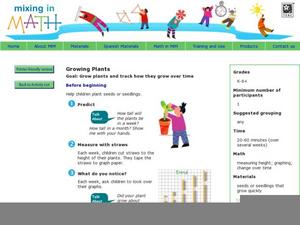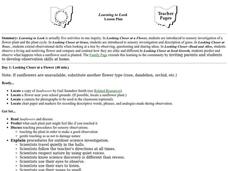Curated OER
How Wathersheds Work
Young scholars describe a watershed. They identify factors that effect the flow of water within a watershed. They explain how water can flow from inland waterways to the ocean.
Curated OER
A'planting We will Go
Germination is an amazing process that results in amazing things. The book The Tiny Seed is the inspiration for a set of activities that will help build early literacy, observation, language, and writing skills. The class observes how...
Curated OER
Apple: Seed to Tree
Young scholars grow seeds of an apple and learn about Johnny Appleseed. In this apples lesson plan, students map Johnny Appleseed's travels, learn how he got his name, compare different Johnny Appleseed books, and grow apple seeds...
Curated OER
Vegetable Olympics Shot Put
Learners explore the distribution of plant seeds. In this science instructional activity, students discuss plants that explode in order to spread their seeds. Learners create pea shooters and use dried peas to see how far they will travel.
Curated OER
Plants Reproduce and Grow in Various Ways
Third graders take a walk around the outside of the school and examine their clothing to see if they picked up any seeds while on their walk. They discuss how seeds travel and how a new plant thus can form. They then observe root...
Mixing In Math
Mixing in Math: Growing Plants
Whether you have your class plant seeds or begin when sprouts are visible, math skills are used here to predict and track growth over time. Straw bar graphs show plant height on a given day while the graph as a whole shows changes over...
Curated OER
Investigation Xylem
Students investigate how water travels up the stem of vascular plants by using food coloring to stain the xylem of a number of different plants. They know the function of leaves, stems, and root at the end of the experiment.
University of Maryland
Pollination
Sixteen ounces of honey requires more than 1,000 bees traveling over 100,000 miles and visiting 4.5 million flowers. The presentation includes sexual reproduction in plants, the parts and functions of a flower, pollination,...
NASA
Newton Car
If a car gets heavier, it goes farther? By running an activity several times, teams experience Newton's Second Law of Motion. The teams vary the amount of weight they catapult off a wooden block car and record the distance the car...
Curated OER
Salt is Good On Sunflower Seeds, But What About Cypress?
Students record their observations about growing a cypress plant and putting salt in the plant. In this cypress plant lesson plan, students observe and record what is happening as the cypress plant grows. This gives directions for...
Curated OER
How Much is that Doggy in the Window?
Students use Internet resources to explore information associated with owning a dog. They participate in an on-line scavenger hunt to expand their knowledge of pet ownership.
Curated OER
Learning To Look
Sixth graders investigate a flower plant and the plant cycle. They extend observational skills when looking at a tree by observing, questioning and sharing ideas. They observe a living and nonliving flower and compare and contrast how...
Curated OER
Be a Food Explorer
Young scholars discover the origins of fruits and vegetables. In this nutrition lesson, students research how fruits and vegetables came to the United States via trade routes. Resources are provided.
Curated OER
Rates of Change
For this rate of change worksheet, students read about how to calculate the rate of change in different processes such as plant growth. They are given example problems and practice calculating rates of change.
Curated OER
The Ups and Downs of It: Wind
Students explore the ways in which wind is formed and how it affects our weather.
Curated OER
Growing Plants in Science and Literature, More Than an Empty Pot
Students read The Empty Pot as an introduction to plants. In this planting lesson, students understand a sequence of events in the book and relate it to the sequence of a plants life. Students grow plants and record information in flower...
Curated OER
Plants
In this plants activity, students review the alternation of generations in plants and the function of seeds and flowers for plants. This activity has 11 short answer questions and 4 fill in the blank questions.
Curated OER
Pollination
Third graders discuss pollination and how bees pollinate flowers. In this pollination lesson plan, 3rd graders draw the pollination process on a piece of paper.
Curated OER
Hunting for Measured Treasure
Students compare and contrast objects according to their length. In groups, they travel to different centers in their classroom to participate in different sorting activities. They are introduced to how to use a ruler and reading the...
Curated OER
Johnny Appleseed: A History Lesson
Students explore the life of John Chapman as a History lesson and then reflect on how they might make thier lives more like his.
Calvin Crest Outdoor School
Survival
Equip young campers with important survival knowledge with a set of engaging lessons. Teammates work together to complete three outdoor activities, which include building a shelter, starting a campfire, and finding directions in the...
Curated OER
Epic Improvisation
Really? Rapping The Odyssey? Really. A discussion of the oral tradition of story telling and its links to Epic poetry sets the stage for a series of activities that encourage improvisation to integrate music into other classrooms....
Aurora Trust
Journey Under the Sea
Discover the interesting world of maritime archaeology and explorations under the sea with this nice set of worksheets, which cover such topics as search tools and techniques of underwater archaeology, carbon dating, vessel types, and...
Garden Earth Naturalist Club
Parts of a Flower! Flower Dissection
Sometimes the best way to learn about plants is to see the different parts of a plant yourself. Groups of learners dissect flowers to answer questions about what they observe and what they wonder about their flower.


